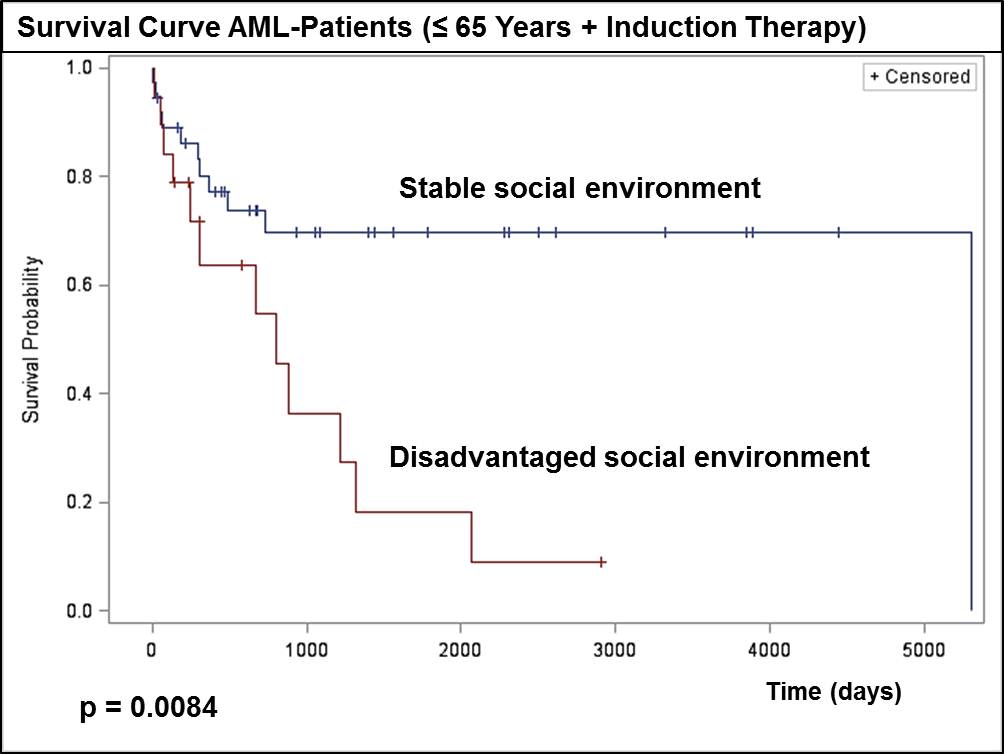Department for Hematology, Oncology, Hemostaseology and SCT

Contributions
Type: Publication Only
Background
The socioeconomic status (SES) is strongly associated with the development and clinical course of several malignant and non-malignant diseases. Only few studies examined the clinical outcome of AML patients in relation to indicators of the social environment at their area of residence, showing divergent country-specific results. So far, no evaluation of area level social differences for survival in AML-patients has been conducted in Germany.
Aims
The aim of the study was to investigate if the social environment in the area of residence is related to complete remission and overall survival of individual AML-patients in the city of Aachen.
Methods
All patients who were treated with a confirmed diagnosis of AML from 1996 – 2014 at the University Hospital in Aachen were assessed retrospectively (n = 139). Clinical and prognostic parameters like age at diagnosis, sex, cytogenetic risk group, primary or secondary AML, curative or palliative intention of treatment were recorded. Patients were assigned to geographical areas using administrative area codes. We classified the social status at the area of residence using area-specific socioeconomic indicators (e.g. proportion of unemployed, crime rate). Based on this index we divided the sample into patients living in high or medium SES areas and those living in low SES areas. Survival analyses were performed using Kaplan-Meier estimator and Log-rank test. Furthermore univariate and multivariate Cox-regression analyses were conducted.
Results
First of all, the distribution of prognostic factors (age at diagnosis, cytogenetic risk group, therapeutic intention) was assessed for the two social environments. No significant differences were detected. Survival analyses for all patients and defined subgroups (stratified by age and therapeutic intention) were performed. Younger patients (≤ 65 years) who received induction therapy with a curative intention showed a significant difference in overall survival (p = 0.0084) between the two social spaces (Figure 1). In the assessment of the clinical course, patients from a social disadvantaged environment reached significantly less often a complete remission (23.1% vs. 12%, p = 0.0039).
Summary
Similar to several solid tumors the socioeconomic environment in the area of residence was significantly related to the clinical course in younger patients with AML. A detailed evaluation of the underlying mechanisms is needed for the improvement of this unsatisfactory situation. As these are findings from analyses not specified in advance confirmation with independent data is needed.
Keyword(s): Acute myeloid leukemia, Outcome

Type: Publication Only
Background
The socioeconomic status (SES) is strongly associated with the development and clinical course of several malignant and non-malignant diseases. Only few studies examined the clinical outcome of AML patients in relation to indicators of the social environment at their area of residence, showing divergent country-specific results. So far, no evaluation of area level social differences for survival in AML-patients has been conducted in Germany.
Aims
The aim of the study was to investigate if the social environment in the area of residence is related to complete remission and overall survival of individual AML-patients in the city of Aachen.
Methods
All patients who were treated with a confirmed diagnosis of AML from 1996 – 2014 at the University Hospital in Aachen were assessed retrospectively (n = 139). Clinical and prognostic parameters like age at diagnosis, sex, cytogenetic risk group, primary or secondary AML, curative or palliative intention of treatment were recorded. Patients were assigned to geographical areas using administrative area codes. We classified the social status at the area of residence using area-specific socioeconomic indicators (e.g. proportion of unemployed, crime rate). Based on this index we divided the sample into patients living in high or medium SES areas and those living in low SES areas. Survival analyses were performed using Kaplan-Meier estimator and Log-rank test. Furthermore univariate and multivariate Cox-regression analyses were conducted.
Results
First of all, the distribution of prognostic factors (age at diagnosis, cytogenetic risk group, therapeutic intention) was assessed for the two social environments. No significant differences were detected. Survival analyses for all patients and defined subgroups (stratified by age and therapeutic intention) were performed. Younger patients (≤ 65 years) who received induction therapy with a curative intention showed a significant difference in overall survival (p = 0.0084) between the two social spaces (Figure 1). In the assessment of the clinical course, patients from a social disadvantaged environment reached significantly less often a complete remission (23.1% vs. 12%, p = 0.0039).
Summary
Similar to several solid tumors the socioeconomic environment in the area of residence was significantly related to the clinical course in younger patients with AML. A detailed evaluation of the underlying mechanisms is needed for the improvement of this unsatisfactory situation. As these are findings from analyses not specified in advance confirmation with independent data is needed.
Keyword(s): Acute myeloid leukemia, Outcome



